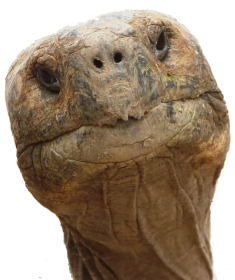Why do some turtles outlive humans?
Feb 09 2017 12:39 AM |
yoik
in Articles

(⇒ write for LongeCity )
References [1] Oldest person ever. Retrieved January 31, 2017, from http://www.guinnessworldrecords.com/world-records/oldest-person
[2]
BBC (2006, March 23). “Clive of India’s” tortoise dies. BBC South Asia. Retrieved from
http://news.bbc.co.uk/2/hi/south_asia/4837988.stm
[3]
Associated Press (2006, June 26). Tortoise believed to have been
owned by Darwin Dies at 176. Fox News. Retrieved from
http://www.foxnews.com/story/2006/06/26/tortoise-believed-to-have-been-owned-by-darwin-dies-at-176.html
[4]
Galapagos tortoise (Geochelone nigra) longevity, ageing, and life
history. Retrieved January 31, 2017, from
http://genomics.senescence.info/species/entry.php?species=Geochelone_nigra
[5]
Hollins, J. (2012). The world’s most isolated vet? Veterinary Record, 171(2), i–i.
doi:10.1136/vr.g7292
[6]
Powell, J., & Caccone, A. (2006). Giant tortoises. Current Biology, 16(5), R144–R145.
doi:10.1016/j.cub.2006.02.050
[7]
Cameron, M. (2008).
COSEWIC Assessment and Status Report on the Snapping Turtle
Chelydra serpentina in Canada
. Retrieved from
http://publications.gc.ca/collections/collection_2009/ec/CW69-14-565-2009E.pdf
[8]
Green sea turtle (Chelonia mydas) longevity, ageing, and life
history. Retrieved January 31, 2017, from
http://genomics.senescence.info/species/entry.php?species=Chelonia_mydas
[9]
Jacobson, E. R. (1994). Causes of Mortality and Diseases in
Tortoises: A Review. Journal of Zoo and Wildlife Medicine, 25(1), 2–17.
[10]
Gibbons, J. W. (1987). Why do turtles live so long? BioScience, 37(4), 262–269. doi:10.2307/1310589
[11]
Flouris, A. D., & Piantoni, C. (2014). Links between
thermoregulation and aging in endotherms and ectotherms.
Temperature, 2(1), 73–85. doi:10.4161/23328940.2014.989793
[12]
Vadala, N. How Long Do Turtles Live? Retrieved January 31, 2017,
from http://www.petmd.com/reptile/care/how-long-do-turtles-live
[13]
Stewart, K. R., & Wyneken, J. (2004). Predation risk to
loggerhead hatchlings at a high-density nesting beach in Southeast
Florida. Bulletin of Marine Science, 74(2),
325–335.
[14]
Gibbons, J. W., & Semlitsch, R. D. (1982). Survivorship and
longevity of a long-lived vertebrate species: How long do turtles
live? The Journal of Animal Ecology, 51(2), 523. doi:10.2307/3981
[15]
Packard, G. C., & Packard, M. J. (2003). Natural
freeze-tolerance in hatchling painted turtles? Comparative
Biochemistry and Physiology Part A: Molecular & Integrative
Physiology, 134(2), 233–246. doi:10.1016/s1095-6433(02)00264-7
[16]
Milton, S. L., & Prentice, H. M. (2007). Beyond anoxia: The
physiology of metabolic downregulation and recovery in the
anoxia-tolerant turtle. Comparative Biochemistry and Physiology
Part A: Molecular & Integrative Physiology, 147(2), 277–290.
doi:10.1016/j.cbpa.2006.08.041
[17]
Shaffer, H. B., Minx, P., Warren, D. E., Shedlock, A. M., Thomson,
R. C., Valenzuela, N., … Wilson, R. K. (2013). The western painted
turtle genome, a model for the evolution of extreme physiological
adaptations in a slowly evolving lineage. Genome Biology, 14(3),
R28.doi:10.1186/gb-2013-14-3-r28
[18]
Garbarino, V. R., Orr, M. E., Rodriguez, K. A., & Buffenstein,
R. (2015). Mechanisms of oxidative stress resistance in the brain:
Lessons learned from hypoxia tolerant extremophilic vertebrates. Archives of Biochemistry and Biophysics, 576,
8–16. doi:10.1016/j.abb.2015.01.029
[19]
von Zglinicki, T. (2002). Oxidative stress shortens telomeres. Trends in Biochemical Sciences, 27(7), 339–344.
doi:10.1016/s0968-0004(02)02110-2
[20]
Jackson, D. C. (2000). Living without oxygen: Lessons from the
freshwater turtle. Comparative Biochemistry and Physiology Part A:
Molecular & Integrative Physiology, 125(3), 299–315.
doi:10.1016/s1095-6433(00)00160-4
[21]
Krivoruchko & Storey, 2010).
[22]
Sandmeier, F. C., Tracy, C. R., Dupre, S., & Hunter, K. (2012).
A trade-off between natural and acquired antibody production in a
reptile: Implications for long-term resistance to disease. Biology
Open, 1(11), 1078–1082. doi:10.1242/bio.20122527
[23]
Bilinski, T., Paszkiewicz, T., & Zadrag-Tecza, R. (2015).
Energy excess is the main cause of accelerated aging of mammals. Oncotarget, 6(15), 12909–12919.
doi:10.18632/oncotarget.4271
[24]
Casares, M., Honegger, R. E., & Rubel, A. (1995). Management of
giant tortoises Geochelone elephantopus and Geochelone gigantean at
Zurich Zoological gardens. International Zoo Yearbook, 34(1),
135–143. doi:10.1111/j.1748-1090.1995.tb00671.x
[25]
Global, S. D. Z. (2010). Galapagos tortoise fact sheet. Retrieved
January 31, 2017, from
http://library.sandiegozoo.org/factsheets/galapagos_tortoise/tortoise.htm
[26]
Curtin, A. J., Zug, G. R., & Spotila, J. R. (2009). Longevity
and growth strategies of the desert tortoise (Gopherus agassizii)
in two American deserts. Journal of Arid Environments, 73(4-5),
463–471. doi:10.1016/j.jaridenv.2008.11.011
[27]
Hayflick, L. (1965). The limited in vitro lifetime of human diploid
cell strains. Experimental Cell Research, 37(3), 614–636.
doi:10.1016/0014-4827(65)90211-9
[28]
Goldstein, S. (1974). Aging in vitro. Experimental Cell Research, 83(2), 297–302.
doi:10.1016/0014-4827(74)90342-5
[29]
Hayflick, L., & Moorhead, P. S. (1961). The serial cultivation
of human diploid cell strains. Experimental Cell Research, 25(3), 585–621. doi:10.1016/0014-4827(61)90192-6
[30]
Harley, C. B., Futcher, A. B., & Greider, C. W. (1990).
Telomeres shorten during ageing of human fibroblasts. Nature, 345(6274), 458–460. doi:10.1038/345458a0
[31]
Girondot, M., & Garcia, J. (1999). Senescence and longevity in
turtles: What telomeres tell us. 9th extraordinary meeting of the
societas Europaea Herpetologica, 1, 25–29. Retrieved from
//www.researchgate.net/publication/252290006_Senescence_and_longevity_in_turtles_What_telomeres_tell_us
[32]
Miller, J. K. (2001). Escaping senescence: Demographic data from
the three-toed box turtle (Terrapene carolina triunguis). Experimental Gerontology, 36(4-6), 829–832.
doi:10.1016/s0531-5565(00)00243-6
[33]
Schächter, F., Cohen, D., & Kirkwood, T. (1993). Prospects for
the genetics of human longevity. Human Genetics, 91(6), . doi:10.1007/bf00205074
[34]
Warner, D. A., Miller, D. A. W., Bronikowski, A. M., & Janzen,
F. J. (2016). Decades of field data reveal that turtles senesce in
the wild. Proceedings of the National Academy of Sciences, 113(23),
6502–6507. doi:10.1073/pnas.1600035113
|
Search Articles |
-


 Sign In
Sign InGoogle Sign in options
- Create Account








































0 Comments